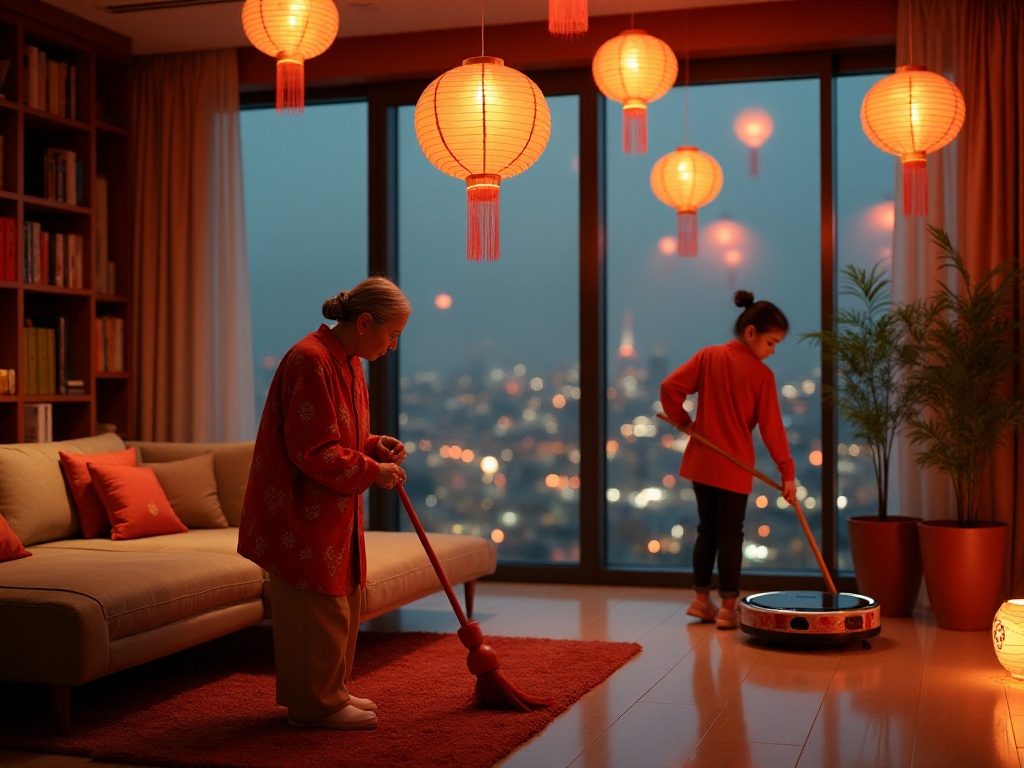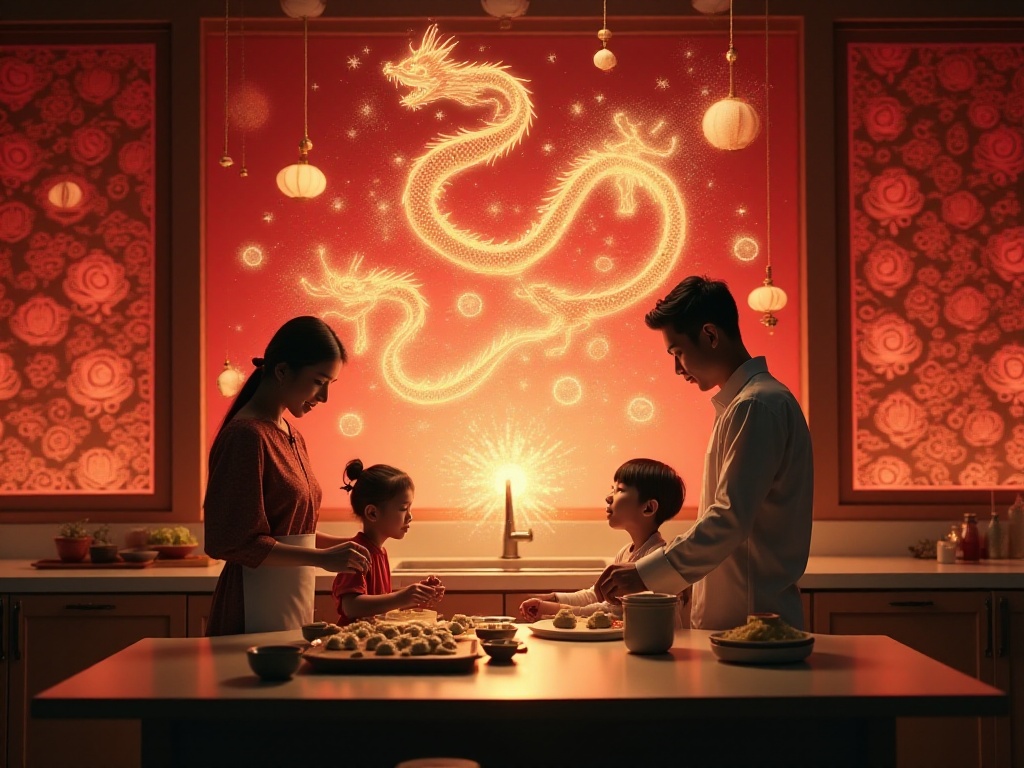I've been pondering a question lately: why do we always feel overwhelmed during Chinese New Year? Despite being the most important traditional holiday, we often end up exhausted from various tasks. As a post-95s generation who has lived independently for many years, I deeply understand how crucial life skills are during traditional festivals. Having worked in big cities these years, far from hometown, I especially miss home during Spring Festival. Seeing young people around me busy preparing for the New Year, I decided to share my "Chinese New Year survival guide" that I've figured out over the years, hoping to help more young people like me.
I remember last year on New Year's Eve morning, my mom called asking, "Have you cleaned your house?" I slapped my forehead, just remembering I needed to clean. In our hometown, it's customary to thoroughly clean the house before the New Year, called "sweeping dust." This tradition has a long history, reportedly dating back to the Shang and Zhou Dynasties. In ancient times, people would perform the Kitchen God worship ceremony on the twenty-fourth day of the twelfth lunar month, then begin thoroughly cleaning their houses to welcome the New Year with tidiness.
Young people today might find these traditions too complicated, but these customs actually contain profound cultural meanings. Sweeping dust isn't just simple cleaning, but a ritual of bidding farewell to the old and welcoming the new. When I first started working, I always found cleaning troublesome and often delayed until the last minute. Later, I gradually developed a method: starting preparation on the twenty-eighth day of the twelfth lunar month, using a special notebook to record areas needing cleaning, and cleaning in order from top to bottom, inside to outside.
Speaking of specific cleaning tips, I've summarized many practical methods over the years. For example, cobwebs on ceilings and corners can be cleaned by wrapping a cloth around a mop, which is both effortless and thorough. For stubborn stains on windows, wiping with newspaper dipped in white vinegar works especially well and doesn't leave water marks. The range hood is the most difficult to clean, but I discovered that soaking it in a mixture of baking soda and white vinegar makes it easy to remove grease.
The grout between bathroom tiles is also a headache. Now I use a toothbrush dipped in a mixture of baking soda and lemon water to scrub, which not only removes dirt but also eliminates odors. Floor cleaning is also crucial - I first use a vacuum cleaner to remove dust, then mop with warm water mixed with a few drops of essential oil, making the room both clean and fresh-smelling.
Fabric items like curtains, sofa covers, and pillowcases should also be washed. I choose to wash them on sunny days for convenient drying. If it's raining, these fabrics can be dried near radiators, but remember to flip them frequently to avoid partial dampness and mold.
Cleaning various appliances shouldn't be neglected. If air conditioner filters aren't cleaned for too long, they not only affect cooling and heating efficiency but may also breed bacteria. Now I remove and wash the air conditioner filters with warm water during every major cleaning, drying them before reinstalling. The refrigerator should also be cleaned, throwing out expired food and wiping the interior with food-grade baking soda water, which both disinfects and prevents odors.
Ancestor worship is one of the most solemn rituals during Spring Festival. In our hometown, we choose the twenty-ninth day of the twelfth lunar month for this. This tradition embodies Chinese people's respect for their ancestors and is our way of expressing gratitude to our forebears. When I first started living independently, I would always be flustered during ancestor worship, often forgetting to prepare some necessities. Now I've developed a habit of making detailed preparation lists in advance.
First is preparing worship items. Basic items include incense, joss paper, and fresh flowers. Choose smokeless incense, which is both environmentally friendly and won't cause smoke irritation. There are many types of joss paper; we usually prepare gold and silver paper, spirit money, etc. Additionally, we need to prepare some offerings, typically including fruits, pastries, and beverages. Fruits should be seasonal; we usually prepare auspicious fruits like apples and tangerines. For pastries, choose traditional ones like rice cakes and cookies. For beverages, usually white spirits or yellow wine are chosen.
Young people living in big cities might find preparing these items troublesome, but online shopping is very convenient now. I order online two weeks in advance, which not only offers complete variety but is also cheaper than physical stores. However, be sure to check merchant reviews to ensure purchasing quality-guaranteed products. Last year I solved the worship supplies issue through online shopping, saving both time and effort.
The worship ceremony also has its protocols. Generally, first arrange the offerings, then light incense and bow. When bowing, maintain a sincere attitude and proper movements. If worshipping at home, choose a quiet place to set up the ancestral tablets. If visiting ancestral graves, best check the cemetery environment a day ahead and clear any weeds if necessary.
Many young people now might think these complicated rituals unnecessary, but I believe these traditional ceremonies are very meaningful. They're not only about respecting ancestors but also about cultural inheritance. Through this way, we can understand our roots and feel family cohesion.

The New Year's Eve dinner can be said to be the most important meal of Spring Festival. It's not just an ordinary dinner but carries the expectation and joy of family reunion. As a young person often responsible for preparing the New Year's Eve dinner, I deeply understand its challenges. The dumpling-making process especially used to trouble me. The dumpling wrappers would either be too thick and hard, or the dumplings would be loosely wrapped and leak filling. Later, I learned the correct dumpling-making method online: first let the dough rest properly, when rolling the wrappers pay attention to even force, making edges thinner than the center. When wrapping, dip chopsticks in water along the wrapper edge, so it won't crack when sealing.
To prepare the New Year's Eve dinner more easily, I invented a "Lazy Person's New Year's Eve Dinner Planning Table." Specifically: start planning the menu a week ahead, considering the balance of meat and vegetable dishes, and family members' taste preferences. Purchase ingredients in three phases - first buy seasonings and dry goods, then vegetables and meat that can be stored for a few days, and finally fresh seafood and perishable ingredients on the last day.
New Year's Eve dinner preparation also requires proper order. I start preparing on New Year's Eve morning, first handling ingredients needing marination, like cured meat and salted fish. Then prepare vegetables, processing all ingredients that need cutting in advance and organizing them by category. This makes cooking much easier in the evening. Cooking order is also important - first cook dishes that don't cool easily, leaving dishes best served hot for last.
Regarding dish selection for New Year's Eve dinner, I think we should have both traditional New Year dishes and innovation. For example, fish is essential, symbolizing surplus every year. But cooking methods can be innovative - not necessarily just steamed, could try sauerkraut fish or braised fish. Spring rolls symbolize gold bars, representing good fortune. The red color of shrimp represents festivity, and its pronunciation resembles "haha," representing laughter.

Giving red envelopes is indeed a challenge for young people who have just started working. I remember my first time giving red envelopes, worried about giving too little showing lack of respect, yet afraid of exceeding my financial capacity. Later I developed a method: first record last year's received red envelope amounts in notes for a general understanding of the market rate. Then adjust based on local price levels and personal financial situation.
Red envelope amounts should also be decided based on generation and relationship closeness. Generally, red envelopes for elders should be more than for juniors. Those for closer relatives should be more than for general relatives. But specific amounts should still be within one's means, don't exceed your capacity for face.
Electronic red envelopes are now popular, but for traditional festivals like Spring Festival, I still recommend preparing physical red envelopes. Physical envelopes have more ceremonial feeling, and you can choose nice-looking red envelope designs to add festive atmosphere. When preparing red envelopes, notes should be newer, best to exchange new bills at the bank in advance.

Festival decorations are an important part of creating holiday atmosphere. I remember when I first started working, my rented apartment always lacked New Year feeling. Later I gradually figured out some decoration tips. First is timing - I now start preparing decorations at the beginning of the twelfth lunar month to avoid price increases and have more choices.
Decoration selection should consider color matching. Red is the main color, can be matched with gold and pink to add festivity. Spring couplets are the most basic decoration, choose appropriate size with upright and strong characters. Window flowers can be paper-cut style, both traditional and artistic. Lantern selection should be based on room size - too large feels oppressive, too small feels thin.
I discovered a practical trick: transform received red envelope bags into decorations. Those beautiful red envelopes can be cut into various shapes and pasted on walls, both environmentally friendly and beautiful. Can also string these decorations together with red rope to make New Year hangings.
Besides traditional decorations, can now add some modern elements. For example, can buy some LED string lights, very atmospheric when lit at night. If you have plants, can also decorate them, tie some red ribbons or small ornaments.

After every New Year, dealing with the aftermath is most headache-inducing. House full of various decorations and gift boxes can become chaos if not tidied promptly. Through years of experience, I've summarized a storage method. First prepare storage boxes before New Year, preferably transparent ones so you can see contents at a glance. Then label categories like "decorations," "gifts," "New Year goods," etc., making them easy to find next year.
Decoration storage needs special attention. Spring couplets and fu characters can actually last several years if properly stored. I carefully roll them up, wrap in newspaper, and store in dry places. For foldable lanterns, fold and place in storage boxes. For rigid ones, need larger boxes to avoid damage.
Gift storage is also important. First categorize received gifts, note expiration dates for food items, eat soon what can be eaten soon. Other items should be stored by purpose, best label storage boxes with item names and received dates.
New Year goods storage has its methods too. Store dry goods in cool dry places, best in sealed jars. Snacks need moisture prevention, can be packed in food seal bags then placed in storage boxes.

These years' experience has made me deeply realize that having a good Spring Festival is indeed technical. It requires us to both inherit traditions and keep up with the times, using modern ways to solve problems. For example, many young people now use smart home devices to help with housework, electronic red envelopes instead of paper ones - these are all good innovations.
But regardless of changes, the most important aspects of Spring Festival are still the joy of reunion and inheritance of tradition. Each family has their own New Year customs, each place has its unique New Year atmosphere. As the new generation, we should learn to add some new elements while maintaining traditions, making Spring Festival both ceremonial and novel.
Finally, I want to say that the most important thing about New Year isn't how grand the form or how complete the etiquette, but making every family member feel warmth and love. Hope everyone can find their suitable way to make Spring Festival both relaxing and happy. After all, this is our Chinese people's most important festival, worth our careful attention.
Do you have any unique Spring Festival life skills? Welcome to share your experience. Perhaps your small tip could help others solve a big problem?
Let's work together to make traditional festivals both meaningful and joyful. After all, Spring Festival belongs to every Chinese person, let's jointly inherit this beautiful cultural heritage.
 Previous
Previous
